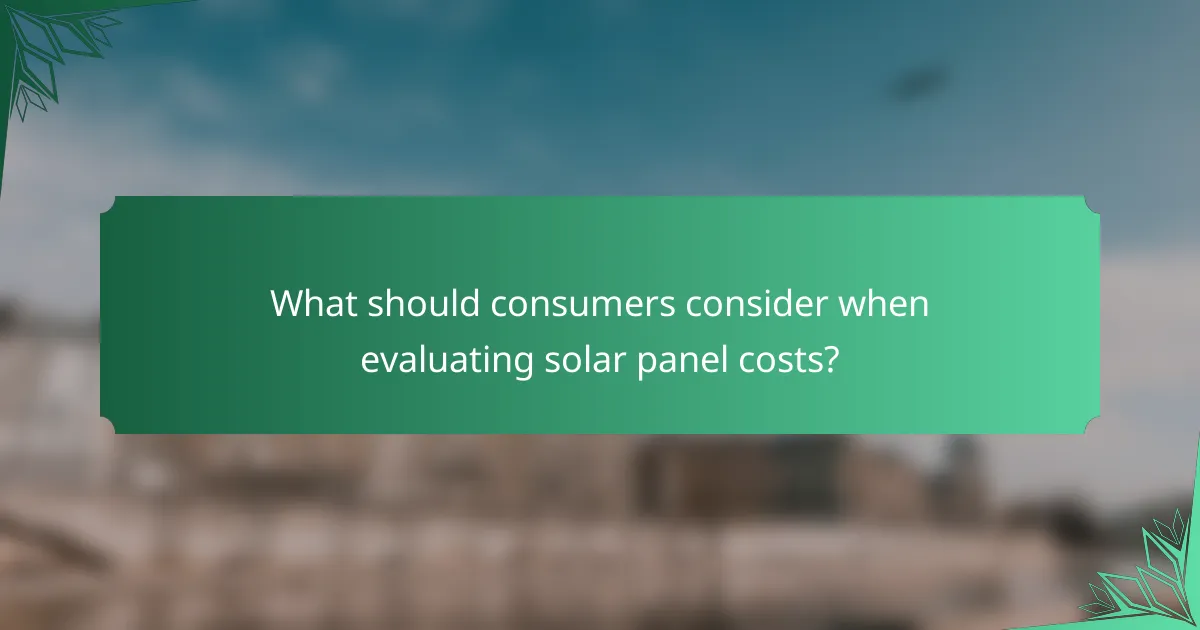
What are the current trends in solar panel costs?
Current trends in solar panel costs show a significant decline. Prices have dropped by approximately 80% since 2010. The average cost of solar panels in the U.S. is now around $2.50 per watt. This trend is driven by advancements in technology and increased production efficiency. Government incentives and tax credits also contribute to lower costs. Additionally, global supply chain improvements enhance affordability. Market competition among manufacturers further reduces prices. These factors collectively indicate a continued downward trend in solar panel costs.
How have solar panel costs changed over the past decade?
Solar panel costs have significantly decreased over the past decade. In 2010, the average cost was approximately $4.50 per watt. By 2020, this figure dropped to around $0.90 per watt. This represents a decline of over 80%. The reduction in costs is attributed to advancements in technology and increased manufacturing efficiency. Additionally, government incentives and subsidies have made solar energy more accessible. Market competition has also played a crucial role in driving prices down. These factors collectively contributed to the affordability of solar panels for consumers.
What historical data illustrates the fluctuation of solar panel prices?
Historical data shows that solar panel prices have significantly decreased over the past few decades. In 2010, the average price per watt for solar panels was around $3.50. By 2020, this price had dropped to approximately $0.90 per watt. This decline is attributed to advancements in technology, increased production efficiency, and economies of scale.
According to the International Renewable Energy Agency (IRENA), the global weighted-average cost of solar photovoltaics fell by 82% between 2010 and 2019. Furthermore, market dynamics, such as government incentives and competition among manufacturers, have also influenced price fluctuations.
In 2021, the price of solar modules experienced a slight increase due to supply chain disruptions and rising material costs. However, the long-term trend remains a decrease in solar panel prices, making solar energy more accessible to consumers.
Which factors have most significantly impacted historical price changes?
Technological advancements have significantly impacted historical price changes in solar panels. Innovations in manufacturing processes have reduced costs over time. For example, the introduction of more efficient photovoltaic cells has improved energy conversion rates. Economies of scale have also played a crucial role. As production increased, the cost per unit decreased. Government incentives and subsidies have further influenced pricing by making solar technology more accessible. Market competition among manufacturers has driven prices down as well. According to the International Renewable Energy Agency, the cost of solar photovoltaic systems fell by 82% between 2010 and 2019. These factors collectively explain the significant price changes observed in the solar panel market.
What are the projected future trends for solar panel costs?
The projected future trends for solar panel costs indicate a continued decline. Analysts predict costs will decrease by 15-25% over the next five years. This trend is driven by advancements in technology and increased production efficiency. The International Renewable Energy Agency (IRENA) reported that solar module prices fell by 82% from 2010 to 2019. Additionally, economies of scale from larger manufacturing capacities contribute to lower prices. Market competition among suppliers also plays a significant role in cost reduction. As installation techniques improve, labor costs are expected to decrease as well. Overall, these factors suggest that solar panel costs will remain on a downward trajectory.
How do market forecasts predict solar panel pricing in the next five years?
Market forecasts predict solar panel pricing in the next five years through analysis of supply and demand trends, technological advancements, and policy changes. Analysts examine historical price data to identify patterns. They consider factors like material costs and manufacturing efficiency. Predictions often incorporate government incentives and renewable energy mandates. Market research firms utilize models to estimate future pricing. Reports from organizations like the International Energy Agency provide insights. For instance, the IEA’s World Energy Outlook indicates a potential decline in costs due to innovation. These forecasts help stakeholders make informed investment decisions.
What technological advancements could influence future costs?
Technological advancements in solar panel efficiency and manufacturing processes could significantly influence future costs. Innovations such as bifacial solar panels increase energy capture, leading to higher efficiency. Advanced materials like perovskite cells promise lower production costs and improved performance. Automation in manufacturing reduces labor costs and enhances scalability. Energy storage technology advancements can lower overall system costs by increasing solar utility. Research indicates that these technologies could reduce solar energy costs by up to 50% by 2030. As these advancements progress, they will likely drive down prices for consumers and increase market adoption.

What market influences affect solar panel pricing?
Solar panel pricing is influenced by several market factors. Supply and demand dynamics significantly impact prices. When demand increases, prices tend to rise. Conversely, when supply outstrips demand, prices may decrease.
Government policies also play a crucial role. Subsidies and tax incentives can lower costs for consumers, affecting overall market pricing. Trade tariffs on imported solar panels can increase prices as well.
Technological advancements lead to more efficient manufacturing processes. These improvements can reduce production costs and lower retail prices.
Market competition among manufacturers affects pricing strategies. Increased competition often results in lower prices for consumers.
Global economic conditions influence solar panel pricing too. Fluctuations in currency values can affect import costs, impacting retail prices.
Lastly, raw material costs, such as silicon and metals, directly affect production expenses. As these costs change, they can lead to adjustments in solar panel pricing.
How do government policies impact solar panel costs?
Government policies significantly impact solar panel costs. Subsidies and tax incentives lower the overall price for consumers. For example, the federal Investment Tax Credit (ITC) allows homeowners to deduct a percentage of solar installation costs from their taxes. This credit has been crucial in making solar energy more affordable. Additionally, tariffs on imported solar panels can increase costs. In 2018, the U.S. imposed tariffs on solar panel imports, leading to higher prices. Regulations and standards can also affect production costs and market competition. Overall, supportive policies tend to decrease costs, while restrictive measures can raise them.
What incentives or subsidies are available for solar panel installation?
Federal tax credits provide a significant incentive for solar panel installation. The Investment Tax Credit (ITC) allows homeowners to deduct 26% of the cost of solar systems from their federal taxes. This percentage is set to decrease to 22% in 2023. Additionally, many states offer their own incentives. These can include rebates, tax credits, and performance-based incentives. Local utility companies may also provide rebates for solar panel installation. Programs vary widely by state and utility provider. Homeowners should check their local regulations for specific details. According to the Database of State Incentives for Renewables & Efficiency (DSIRE), over 1,000 incentive programs exist across the U.S.
How have regulatory changes affected market dynamics?
Regulatory changes have significantly impacted market dynamics in the solar panel industry. New policies often incentivize solar adoption through tax credits and subsidies. For example, the Investment Tax Credit (ITC) in the United States has spurred demand, leading to increased installations. Additionally, regulations promoting renewable energy sources have fostered competition among manufacturers. This competition has driven innovation and reduced costs over time. A report by the International Renewable Energy Agency (IRENA) indicates that global solar costs dropped by 82% between 2010 and 2019, largely due to favorable regulatory environments. Such changes have also influenced market entry, allowing new players to emerge and challenge established firms. Overall, regulatory frameworks shape both supply and demand in the solar market.
What role do global supply chains play in solar panel pricing?
Global supply chains significantly influence solar panel pricing. They affect the cost of raw materials, manufacturing, and distribution. For example, silicon is a key component in solar panels. Its price is subject to fluctuations in global supply and demand. Shipping costs and tariffs also impact overall pricing. Disruptions in supply chains, such as those caused by geopolitical tensions, can lead to price increases. Moreover, economies of scale in production can lower costs when supply chains are efficient. According to a report by the International Renewable Energy Agency, supply chain optimization can reduce solar panel costs by up to 15%.
How do material costs influence solar panel manufacturing?
Material costs significantly influence solar panel manufacturing by affecting overall production expenses. The primary materials used in solar panels include silicon, metals, and glass. Fluctuations in the prices of these materials directly impact manufacturing costs. For instance, silicon prices can vary based on supply and demand dynamics in the market. When silicon prices rise, manufacturers face higher production costs, which can lead to increased retail prices for consumers.
Additionally, the cost of metals like silver and aluminum also plays a crucial role. Silver is a key component in solar cells, and its price volatility can significantly affect the cost structure of solar panels. Historical data shows that spikes in metal prices have previously resulted in higher solar panel costs.
Furthermore, manufacturers may seek alternative materials or more efficient production methods to mitigate rising material costs. Innovations in technology can help reduce dependency on expensive materials. Overall, material costs are a critical factor in determining the economic viability and pricing of solar panels in the market.
What geopolitical factors can disrupt supply chains and affect pricing?
Geopolitical factors that can disrupt supply chains and affect pricing include trade policies, political instability, and international sanctions. Trade policies, such as tariffs and import/export restrictions, can increase costs and limit access to materials. Political instability in key manufacturing regions can halt production and lead to supply shortages. International sanctions can restrict trade with specific countries, affecting the availability of components. For example, U.S. tariffs on Chinese solar products have raised prices and impacted supply chains. Additionally, conflicts in resource-rich areas can disrupt logistics and transportation routes, further influencing pricing.

What should consumers consider when evaluating solar panel costs?
Consumers should consider several key factors when evaluating solar panel costs. First, the initial purchase price of the solar panels is critical. This cost can vary widely based on brand, efficiency, and technology. Second, installation costs must be factored in, as they can significantly impact the overall expense. Third, consumers should assess potential savings on electricity bills. The average U.S. household can save between $10,000 to $30,000 over 20 years with solar energy. Fourth, available tax credits and incentives can reduce upfront costs. For example, the federal solar tax credit allows homeowners to deduct 26% of the installation costs from their federal taxes. Additionally, the long-term durability and warranty of solar panels are important. Most panels come with a 25-year warranty, indicating expected lifespan and reliability. Lastly, local regulations and utility policies can affect overall costs. Some areas offer net metering, allowing homeowners to sell excess energy back to the grid, further enhancing financial benefits.
How can consumers find the best value for solar panel installations?
Consumers can find the best value for solar panel installations by comparing multiple quotes from different providers. Research indicates that obtaining at least three estimates can lead to better pricing. Consumers should also evaluate the quality of solar panels offered. High-efficiency panels may have a higher upfront cost but provide better long-term savings. Checking for available incentives, such as federal tax credits or state rebates, can significantly reduce overall costs. Additionally, reading customer reviews and ratings for installers helps identify reputable companies. The Solar Energy Industries Association reports that the average cost of solar has decreased by over 70% since 2010. This trend indicates that consumers can benefit from competitive pricing in the current market.
What are the key attributes to compare when assessing different solar panels?
The key attributes to compare when assessing different solar panels include efficiency, wattage, durability, warranty, and cost. Efficiency measures how well a solar panel converts sunlight into electricity. Higher efficiency ratings indicate better performance in limited space. Wattage indicates the power output of the solar panel. A higher wattage means more energy production. Durability refers to the panel’s ability to withstand environmental factors. Panels with higher durability ratings last longer and require less maintenance. Warranty length provides insight into the manufacturer’s confidence in the product. Longer warranties often suggest higher quality. Cost is crucial for budget considerations. Comparing these attributes helps consumers make informed decisions.
How do installation costs vary by region and provider?
Installation costs for solar panels vary significantly by region and provider. In the United States, installation costs can range from $2.50 to $3.50 per watt. Regions with higher solar incentives, like California, often see lower installation costs due to competition among providers. Conversely, areas with fewer incentives, such as parts of the Midwest, may have higher costs. Providers also influence pricing through their service offerings and installation methods. For example, larger companies may offer lower prices due to economies of scale, while local installers may charge more for personalized service. According to the Solar Energy Industries Association, the average cost of solar installation has decreased by nearly 70% since 2010, reflecting regional and provider variations.
What are common misconceptions about solar panel costs?
Common misconceptions about solar panel costs include the belief that they are prohibitively expensive. In reality, the cost of solar panels has decreased significantly over the past decade. According to the National Renewable Energy Laboratory, the price of solar photovoltaic systems fell by about 82% from 2010 to 2020. Another misconception is that solar panels require high maintenance costs. Most systems require little maintenance, with occasional cleaning and inspections being sufficient. Additionally, some people think solar panels are only cost-effective in sunny regions. However, solar energy can be harnessed effectively in various climates, making it a viable option for many homeowners. These misconceptions can deter potential users from adopting solar technology, despite the financial and environmental benefits.
Why do some consumers underestimate the long-term savings of solar panels?
Some consumers underestimate the long-term savings of solar panels due to initial cost perceptions. The upfront investment can appear high, leading to a focus on short-term expenses. Many consumers fail to consider the cumulative savings on electricity bills over time. Additionally, the payback period may not be well understood. Research shows that solar panels can significantly reduce energy costs, with savings averaging $20,000 over 20 years. Misleading information about solar efficiency and longevity can also contribute to underestimating potential savings.
What hidden costs should consumers be aware of when purchasing solar panels?
Consumers should be aware of several hidden costs when purchasing solar panels. Installation fees can significantly increase total expenses. These costs may include labor, permits, and inspections. Maintenance costs can also add up over time. Regular cleaning and potential repairs are necessary for optimal performance. Additionally, consumers might face costs related to inverter replacement. Inverters typically need replacement every 5 to 10 years. Home modifications may be required to accommodate solar panel systems. Structural assessments and roof repairs can incur extra expenses. Lastly, consumers should consider potential increased insurance premiums. Some insurers may charge more for homes with solar installations.
What practical tips can help consumers navigate solar panel pricing?
Research local incentives and rebates for solar panel installation. Many states offer financial assistance that can reduce overall costs. Compare quotes from multiple solar providers to find competitive pricing. This helps identify the best deals available in your area. Understand the different financing options available, such as loans, leases, or power purchase agreements. Each option has distinct implications for total costs and savings. Evaluate the long-term savings potential by analyzing energy bills before and after installation. This can demonstrate the financial benefits of solar energy. Keep an eye on market trends and solar technology advancements, as these can influence pricing. Awareness of these factors can help consumers make informed decisions.
The main entity of this article is solar panel costs, which encompass historical data, current trends, and future projections. The article details a significant decline in solar panel prices, with an approximate 80% reduction since 2010, driven by technological advancements, government incentives, and market competition. It also examines the factors influencing pricing, such as supply chain dynamics, material costs, and regulatory changes. Additionally, the article outlines projected trends, suggesting further cost reductions in the coming years, while providing practical tips for consumers to navigate solar panel pricing effectively.